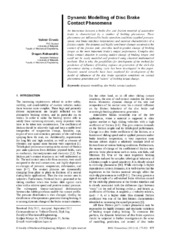Приказ основних података о документу
Dinamičko modeliranje kontaktnih fenomena disk kočnice
Dynamic modeling of disc brake contact phenomena
| dc.creator | Ćirović, Velimir | |
| dc.creator | Aleksendrić, Dragan | |
| dc.date.accessioned | 2022-09-19T16:43:52Z | |
| dc.date.available | 2022-09-19T16:43:52Z | |
| dc.date.issued | 2011 | |
| dc.identifier.issn | 1451-2092 | |
| dc.identifier.uri | https://machinery.mas.bg.ac.rs/handle/123456789/1297 | |
| dc.description.abstract | Interakcija između diska kočnice i frikcionog materijala disk kočnice motornih vozila se odlikuje velikim brojem kontaktnih fenomena. Nastanak ovih fenomena je vezan za radne uslove kočnice (pritisak aktiviranja, brzina, temperatura u kontaktu) kao i za karakteristike materijala frikcionog para. Dinamičke i izraženo nelinearne promene, koje se dešavaju u kontaktu frikcionog para, izazivaju teško predvidivu promenu momenta kočenja, kao najvažnije izlazne performanse kočnice. Složena situacija u kontaktu frikcionog para se ne može lako modelirati i predvideti korišćenjem klasičnih matematičkih metoda. Zbog toga su istraživane mogućnosti razvoja metode za predviđanje uticaja radnih režima disk kočnice na pojavu tzv. 'stickslip' fenomena tokom ciklusa kočenja. Korišćenjem dinamičkih neuronskih mreža, razvijen je dinamički model uticaja radnih uslova disk kočnice na pojavu kontaktnih fenomena i način promene momenta kočenja. | sr |
| dc.description.abstract | An interaction between a brake disc and friction material of automotive brake is characterized by a number of braking phenomena. These phenomena are influenced by brake operation conditions (applied pressure, speed, and brake interface temperature) and material characteristics of a friction couple. The dynamic and highly non-linear changes occurred in the contact of the friction pair, provokes hard-to-predict change of braking torque as the most important brake's output performance. Complex disc brake contact situation is causing sudden change of braking torque and could not be easily modeled and predicted using classical mathematical methods. That is why, the possibilities for development of the method for prediction of influence of braking regimes on generation of the stick-slip phenomena during a braking cycle has been investigated in this paper. Dynamic neural networks have been employed for development of the model of influences of the disc brake operation conditions on contact phenomena generation and 'nature' of braking torque change. | en |
| dc.publisher | Univerzitet u Beogradu - Mašinski fakultet, Beograd | |
| dc.relation | info:eu-repo/grantAgreement/MESTD/Technological Development (TD or TR)/35045/RS// | |
| dc.relation | info:eu-repo/grantAgreement/MESTD/Technological Development (TD or TR)/35030/RS// | |
| dc.rights | openAccess | |
| dc.rights.uri | https://creativecommons.org/licenses/by/4.0/ | |
| dc.source | FME Transactions | |
| dc.subject | dynamic modeling | en |
| dc.subject | disc brake | en |
| dc.subject | contact surfaces | en |
| dc.title | Dinamičko modeliranje kontaktnih fenomena disk kočnice | sr |
| dc.title | Dynamic modeling of disc brake contact phenomena | en |
| dc.type | article | |
| dc.rights.license | BY | |
| dc.citation.epage | 183 | |
| dc.citation.issue | 4 | |
| dc.citation.other | 39(4): 177-183 | |
| dc.citation.rank | M51 | |
| dc.citation.spage | 177 | |
| dc.citation.volume | 39 | |
| dc.identifier.fulltext | http://machinery.mas.bg.ac.rs/bitstream/id/251/1294.pdf | |
| dc.identifier.rcub | https://hdl.handle.net/21.15107/rcub_machinery_1297 | |
| dc.identifier.scopus | 2-s2.0-84859508156 | |
| dc.type.version | publishedVersion |


